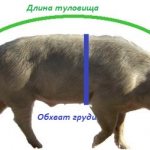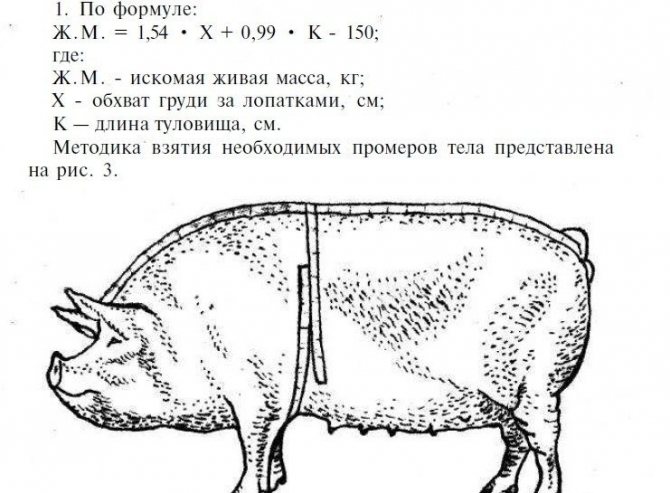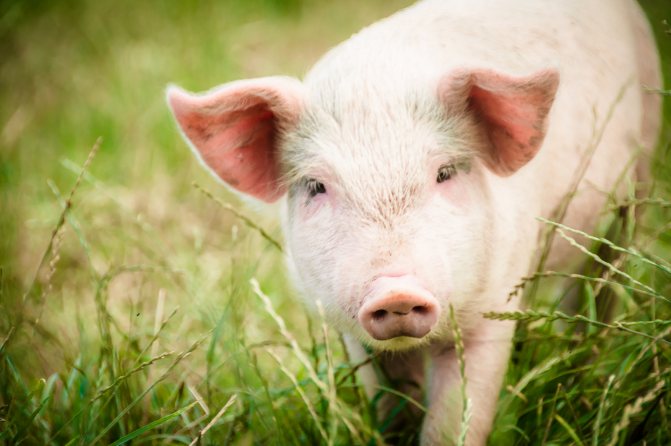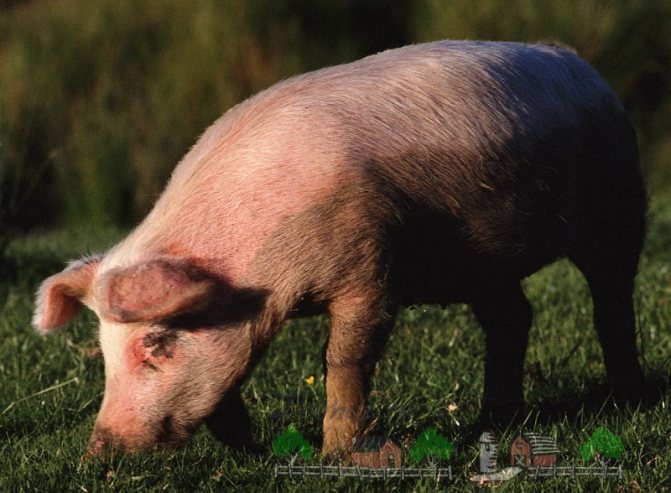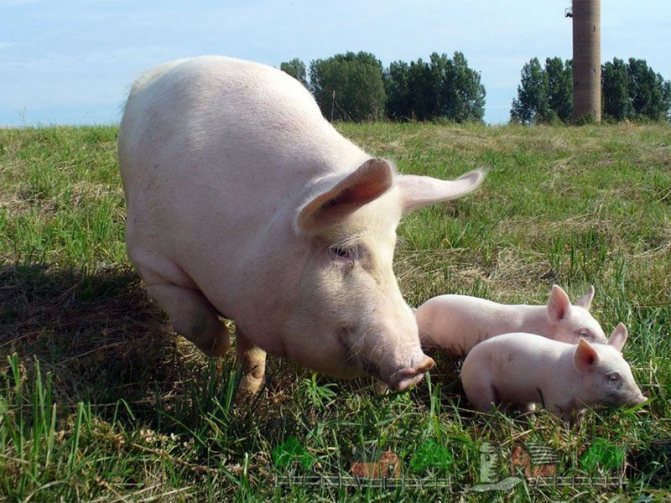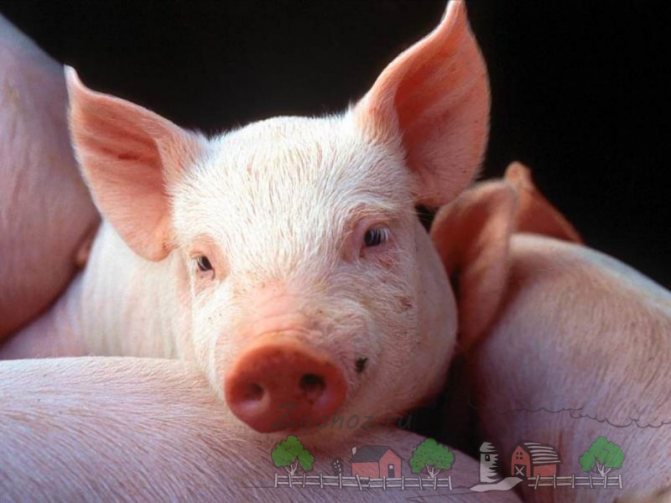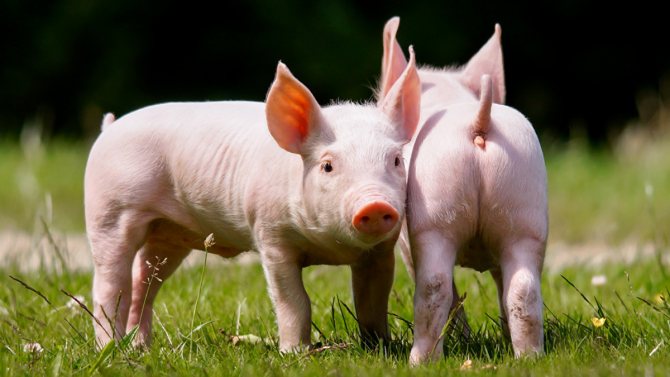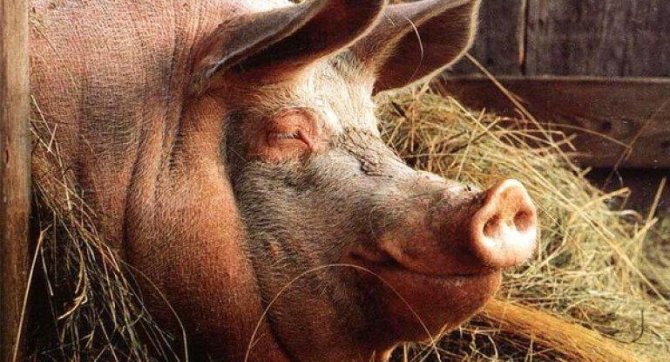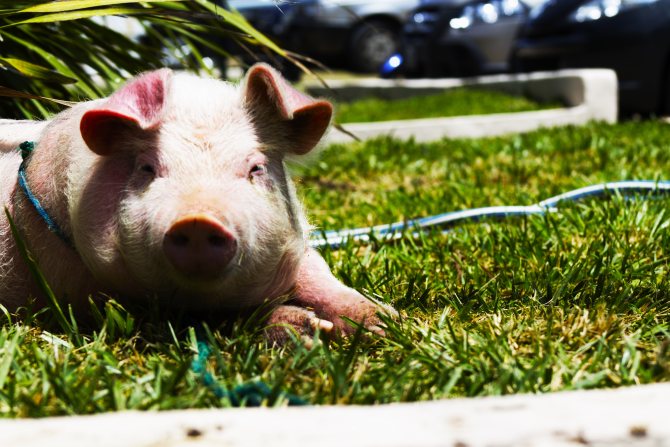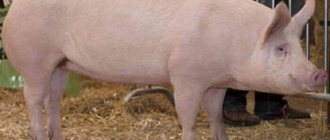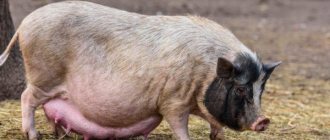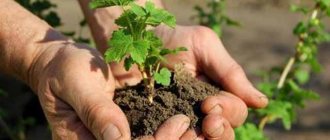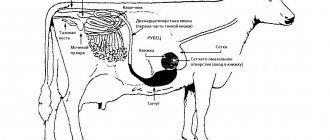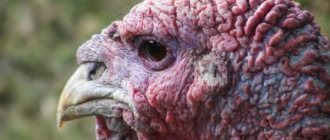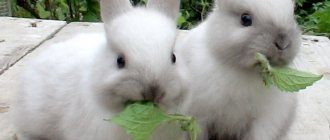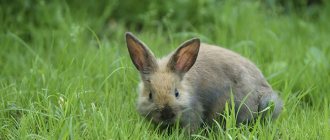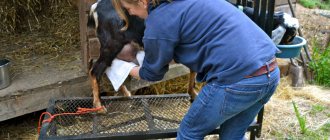Average weight of a pig at different ages
The breeder should decide which of the pig breeds he will breed. Modern breeds are characterized by the fineness of the fat. In the conditions of livestock complexes, they reach a slaughter weight of 100 kg at 23-24 weeks. You can't get lard from them. Fatty breeds are characterized by low growth rates and high feed costs for growth.
Therefore, the large white is considered the optimal breed for breeding in the conditions of small-scale production. It is unpretentious, tolerates adverse conditions well and is distinguished by sustainable productivity. Suitable for the production of meat and lard.
In order to combine the quality and yield of products with profitability, they are guided by the average daily gain of fattened pigs - 650-700 g.
The average weight of animals of different ages is shown in the table:
| Age, days | Live weight, kg |
| 5 | 2 |
| 10 | 3 |
| 20 | 5 |
| 30 | 7 |
| 40 | 10 |
| 50 | 15 |
| 60 | 20 |
| 70 | 26 |
| 80 | 32 |
| 90 | 36 |
| 120 | 45 |
| 150 | 65 |
| 180 | 85 |
| 210 | 110 |
If a livestock breeder plans to raise a uterus, then he must take into account that at the age of seven months, the repair pig reaches puberty. During estrus, growth arrest and even plumb lines are possible. The first mating is carried out at 9-10 months with a live weight of 115-120 kg.
There is a rough estimate of the sow's weight by age. It is believed that after each farrowing, the female adds 25 kg. So, if at the first mating the mass of the average fatness pig was 115 kg, then by the time of the second insemination it is 140, the third - 165 kg, etc.
How to measure the weight of an adult pig
Pigs that have completed growth, that is, animals over 9 months of age, should be considered adults.
The following methods have been developed for measuring live weight without weighing:
- Measurement according to the table.
- Calculation by the formula.
- Calculation by category of fatness.
Measurement by table
To calculate the live weight of the pig, a measuring tape is used. It is most convenient to use one and a half meter tailoring tape. The procedure is carried out in the morning on an empty stomach. Get the animal to stand upright. To do this, the assistant offers her a treat from her hand.
Initially, the length of the body is determined. The tape is applied to the back of the head, stretched to the base of the tail. The second measurement is the girth behind the shoulder blades.
The next step is to determine the weight according to the table. It can be copied from a publication on the Internet and printed. The weight of the animal is determined at the intersection of rows and columns.
If the body length is 102 cm, and the chest circumference behind the shoulder blades is 120 cm, the weight of the pig is 123 kg. The error in determining the mass is within ± 10%.
Calculation by formula
The web provides formulas for calculating weight using the same measurements. For example, the following formula is recommended:
B = 0.99 * D + 1.54 * O-150,
where B is the weight of the animal, D is the length of the body, O is the girth behind the shoulder blades. The result of the calculation is 133 kg. The tabular and calculated results vary greatly. The data in the tables were developed by comparing measurements with weighing results. Therefore, it is better to use them rather than formulas.
Calculation by body condition category
A formula for calculating live weight has been developed as the product of body length and chest girth divided by a coefficient, which for pigs of average fatness is 156. It turns out a greatly underestimated result, in our example 79 kg. Therefore, it is better to use the definition of weight from the table.
Determination of body condition is of practical importance for correcting the diet of pregnant sows.The figure shows the appearance of gilts with different nutritional categories.
Academician V.G. Ryadchikov gives the following criteria for assessing the body condition of sows:
In order to even out the conditions, from 5 to 36 days after mating, skinny animals are fed 4 kg daily, mixed fodder, fatty - 2 kg.
The formula for calculating the weight, taking into account the correction factor
When determining the weight according to this formula, one more parameter is added - the fatness of the pig, which is characterized by correction factors.
Pig breeds are:
Each of them has its own correction factor. Its value, respectively: 142; 156; 162.
Therefore, the formulas will look like:
- for fatty pigs - (OG x DT) / 142;
- for pigs of average fatness - (OG x DT) / 156;
- for thin - (OG x DT) / 162
How to find out how much a piglet weighs
The weight of piglets at birth, as well as in the first weeks of life, is determined on a portable scale. Further determination is carried out by an evaluative method according to the growth change tables. However, upon reaching a weight of 25-30 kg, it is necessary to separate the individuals for herd repair and fattening. Feeding patterns for gilts will vary. This is where measurements come in handy.
Piglet weight table by week
The approximate weight of piglets by rearing week is shown in the table:
| Age, weeks | Live weight, kg |
| 1 | 2,5 |
| 2 | 4,5 |
| 3 | 7 |
| 4 | 9 |
| 5 | 11 |
| 6 | 14 |
| 7 | 18 |
| 8 | 22 |
| 9 | 26 |
| 10 | 30 |
Therefore, measurements should be carried out at the 9-10th week of the pig's life.
Piglet weight by month: table
After setting for fattening or raising replacement young animals, it is recommended to carry out selective control over the live weight of gilts on a monthly basis.
Visually, at least 5 average-sized individuals are selected from each cage, measurements are made and compared with the approximate growth plan presented in the table:
| Age, months | Live weight, kg |
| 3 | 39 |
| 4 | 45 |
| 5 | 65 |
| 6 | 85 |
| 7 | 110 |
Delivery for meat is carried out upon reaching the live weight of 90-110 kg. Further fattening is impractical, since the gains are due to lard, the market value of which is lower than that of meat.
Evaluation of the live weight of pigs by means of measurements allows you to track the dynamics of growth, timely adjust the diet, determine the moment when animals should be taken for meat.
The smallest error is achieved when comparing measurements with tabular data. The method allows you to save on the purchase of expensive equipment.
The most accurate determination of the live weight of pigs is carried out using scales. However, the necessary equipment is not always available at home. How to determine the weight of a pig without weights? The most often used for this is the determination of the mass of a pig by measurements of the chest girth and body length.
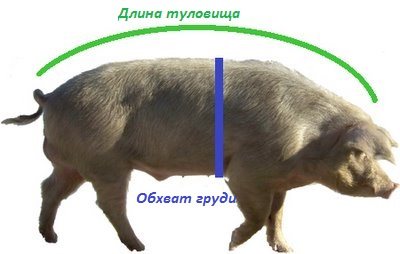
1) The length of the pig's body is measured with a centimeter tape, starting from the middle of the occipital ridge, along the upper line of the neck between the ears, along the withers, back, loin and sacrum to the root of the tail. It is important that when measuring the pig to determine the weight, its head was in a position where the line of the lower jaws, neck and chest would continue the line of the abdomen, that is, it was straight.
2) The chest circumference of a pig is also measured with a measuring tape, focusing on the rear angles of the shoulder blades. Make sure that the tape does not lie loosely on the bristles, but also does not cut into the body. This will help to determine as accurately as possible the weight of the pig without weights.
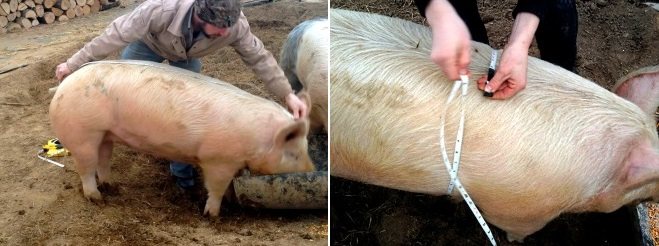

In the future, the table of live weight of pigs will help to determine the weight of pigs.
Pig weight table by measurements (kg)
How to determine the weight of a pig by measurements?


If you are a pig, it will be useful to know that there are five groups of pig nutritional status.
1 group of pigs fatness. These are young animals up to 8 months old for bacon, fed on special feed. The first group includes pigs of white color, without pigmented spots, traumatic injuries, tumors, bruises. In this case, the length of the body must be at least 1 meter.The weight of such pigs ranges from 80 to 105 kilograms. Another important criterion is that the thickness of the fat between the sixth and seventh thoracic vertebrae, above the spinous processes (without the thickness of the skin), should be between 1.5 and 3.5 centimeters.
2 group of fatness of pigs. This is young meat with a live weight of 60 to 130 kilograms. In the mentioned area, the thickness of the lard should be from 1.5 to 4 centimeters. This also includes pigs with a fat thickness of 1 cm and a weight of 20 to 60 kilograms.
3 group of fatness of pigs. These are fatty pigs, including sows and hogs with a minimum of 4.1 cm fat thickness.
4 group of fatness of pigs. These are sows and hogs weighing over 130 kilograms with a fat thickness of 1.5 to 4 centimeters in the mentioned area.
5 group of fatness of pigs. They are suckling pigs with white or slightly pink skin, without bruising, rashes, swelling, bites and wounds.
Now you know how to measure the weight of a pig - a table of the weight of pigs by measurements will help you with this. By the way, in the same way you can find out the weight of cattle and young cattle. If you are interested in the peculiarities of raising newborn pigs, the rules for giving compound feed to piglets, feed for pigs, as well as the features of greasy, meat and bacon feeding, you can learn about it from our separate articles.
Pig measurements
In a home or small farm environment, it is not always possible to weigh an adult pig to determine its weight. Pig measurements can be used to determine the most accurate weight without weighing. In this case, it is necessary to measure two distances (measurements). Measurements are taken 2-3 hours before the daytime feeding of the animal, that is, on an empty stomach. To obtain accurate and correct measurements, the pig must be made to stand correctly: the head does not hang down but is raised at the level of the back, the legs are upright, straight. A centimeter is used to measure the length of the body from the root of the tail to the occipital crest of the pig, and then the circumference of the chest behind the shoulder blades, the measurement locations are shown in the figure.


Pig measurement scheme
To determine the approximate weight after measuring the pig, combine the data with the numbers in the table below, and look at the weight of the pig at the intersection of the two lines (horizontal and vertical).


Table of the ratio of measurements and weight of a pig.
The second way is to find out the weight of the pig. Another way to find out the approximate weight of a pig is by measuring and not even using the pig weight chart here. This method is as follows - the pig is measured, as in the first method, and then the results of the measurement must be multiplied among themselves, and the resulting figure must be divided by the fatness coefficient of the pig. Which in this method is determined by the "eye": if the animal is thin, a coefficient of 162 is used, with normal fatness - a coefficient of 156, and a good fat content - 142. We recommend reading: Cutting a pig carcass. Business plan for raising and breeding pigs. Calculation of economic efficiency. The qualitative composition of pig feed used for fattening. Pig feed. Rationing and preparation of food rations. Growth of piglets and milk production of sows with the combined addition of various preparations of biologically active substances to their diet. Breed characteristics of pigs selected for fattening. Technological methods to prevent stress in pigs and piglets. Pig disease prevention. Veterinary medicinal plants for pigs. The best conditions for raising sows. Practical experiment. Pig mating.
How to get 30 piglets from a sow per year.
Boar semen - assessment of quality and volume depending on the breed and the season of the year. Diseases and treatment of pigs. Management of veterinary drugs in a modern industrial pig farm. Disposal of animal waste. Sanitary and hygienic aspects of the process of anaerobic biological fermentation of waste.
Every pig breeder should be able to calculate the weight of a pig at different periods of the animal's life.In small private farms, it is difficult to recognize the mass of pets, since adults weigh a lot. In this case, farmers resort to methods that allow them to determine the mass of the animal with the smallest error.


Slaughter and processing
The weight value of cattle varies considerably based on breed characteristics. You can find out how much a cow weighs on average, based on the standard values of a particular breed.
There are three main groups:
- Beef cattle;
- Lactic;
- Meat and milk.
Animals of beef breeds are distinguished by an intensive increase in body weight and a large maximum weight. In dairy cattle, live weight grows more slowly, but is highly stable.
The weight of a newborn calf is 7-9% of the mother's weight, which corresponds to 35-45 kg, dairy calves are smaller, their weight starts from 20 kg. The average daily weight gain of newborn calves is 700 g (for dairy and meat) and 600 g (for dairy breeds).
Monthly calves can weigh up to 60 kg, depending on the feeding intensity. By the age of one year, gobies can reach a mass of 250-400 kg. Cows reach the size of 500-600 kg, live weight of bulls-producers is 700-1100 kg. The largest bull in the world has reached a mass of over 1900 kg. The world's largest wild-breed bulls live in Vietnam and China.
Before you start breeding broilers on your own farm, it is worth exploring the pros and cons that this activity entails.
Let's see why poultry farmers are raising broiler chickens:
- A large, suitable for consumption individual grows very quickly - in 40-45 days, which makes it suitable for breeding even in a seasonal dacha farm.
- Fast-growing breeds of chickens can be kept throughout the year, creating the proper living conditions for them. Conveyor content is also permissible.
- The meat of broiler chickens is tender, tasty and quickly cooked.
- The poultry farmer is always confident in the quality of his own products, because he knows what his wards ate and treated, what kind of care they took.
- You can calculate the cost of feed in advance, since it takes a certain amount of time to raise these chickens, and there is no point in keeping and feeding them for longer than the required period.
- Broilers do not need walking areas, their main task is to eat and gain weight.
- The carcass of a broiler chicken is easily and quickly plucked.
Slaughtering a chicken can be done in several ways. Beginners should use the easiest and fastest. These include decapitation. For this procedure, you need a sharp ax or you can use a knife. The bird needs to be tied up by its paws and put in a bag so that its head is free.
Another way is to rotate the chicken quickly while holding it by the paws. Then they cut her throat with a very sharp knife.
The above methods are external.
The internal method is used when slaughtering in large poultry farms. The bird is stunned for humane purposes. The process is put on the conveyor and the person practically does not take part in this.
Regardless of the method you decide to use, processing the carcass will look the same:
- the bird is placed head down to allow blood to drain;
- the chicken is gutted and plucked;
- the carcass is cut;
- the chicken is packaged for storage.
For external slaughter, the jugular vein, facial and carotid arteries are cut at a distance of 20 cm just below the ear. Hold the carcass over the tray for 2 minutes to drain the blood. During this time, the feathers adhere more tightly to the carcass, which adds a scalding procedure to the processing process. This is done by hot water or steam treatment and reduces the holding force of the feathers by 80%. The plumage is removed using disc and centrifugal apparatus. This allows the carcass to maintain a presentable appearance.
If there is fluff left, then use the waxing method. For this, the chicken is placed in a special bathroom and dipped several times in wax mass, which is removed using a feathering machine. During evisceration, the following operations are performed: cut off the paws, cut the abdomen, remove the insides. Then the second cervical vertebra is cut off, the trachea and esophagus are removed.
Sometimes farmers report poor growth of broilers. This is explained by the following reasons:
- Inappropriate temperature regime in the chicken coop. Upon reaching the age of 15 days, a temperature of 30 degrees is set in the hen house. After 15 days, it is reduced to 25.
- Bad light. In the first week, the chicken coop is lit around the clock.
- Wrong diet. Avitaminosis is a common cause of insufficient growth.
- Failures in feeding mode. Sometimes birds do not have enough food or water. In this case, the internal resources of the body are used to increase growth.
- Parasites. If chicks are infected with helminths, their development slows down.
Broilers are very attractive poultry in terms of their return on investment.
Broiler chickens are fast growing and gain sufficient weight for slaughter within 8 weeks. Chickens during this period grow on average up to 2 kg, and males - up to 2.5-2.8 kg. This weight is enough for the birds to have an attractive presentation, and the carcass contains a lot of tasty meat.
There is no particular sense in keeping broilers for more than 3-4 months. The amount of food they eat will be high and their weight gain will be slow. Therefore, those farmers who raise broilers for meat find it unprofitable to leave the poultry and send it to slaughter.
DETAILS: Owner reviews of Vietnamese pot-bellied pigs
In order for the chickens to grow well during this period and not cause trouble for the poultry farmer, it is worthwhile to engage in disease prevention. According to the reviews of experienced breeders, if the chickens get sick, then this will immediately affect their weight and the marketable attractiveness of the carcass. Here are the main points to look out for when raising broilers:
- Carry out regular cleaning in the chicken coop. Once every 2 weeks, pour boiling water over all drinkers and feeders. As litter becomes dirty in the house, it is replaced with a new one. A lime powder is made under the hay.
- In the room where birds live, you need to make good ventilation, which contributes to a significant decrease in the concentration of pathogenic bacteria in the air.
- A container with sand and ash for bathing broiler chickens helps prevent skin diseases in birds.
- Regular walks of chickens in the fresh air on grazing will help them to be in motion, which will have a beneficial effect on the development of the musculoskeletal system and weight gain.
- Broiler diets should be as varied and balanced as possible. A sufficient amount of greens, fish and meat and bone waste, vegetables and cereals - all this will give the body of chickens all the necessary substances for growth.
If, according to the observation of the poultry farmer, it becomes obvious that the chickens do not receive all the necessary substances, it is worth resorting to using commercial food additives for poultry. The manufacturer includes everything necessary in their composition so that the chickens do not get sick and develop correctly.
Since the main goal in growing broilers is to get as much meat as possible in a short time, it makes no sense to keep them longer than the prescribed period: after that they gain weight slowly or stop altogether, but they still eat a lot. Mass is gained mainly due to fat.
The taste of meat also changes for the worse: it becomes tough and dry.
Depending on the breed, the bird is ready for slaughter in 6–8 weeks.
The meat yield is the difference between the weight of a gutted and plucked carcass without legs and head and the weight of a live bird. The output is calculated as a percentage. It is believed that in broilers this value ranges from 60 to 80%, the average yield is 70%. However, much depends on the breed, conditions of detention, past diseases and other factors.
To raise broilers, you need to work hard - this is a rather troublesome business, but a novice poultry farmer can cope with it with some theoretical training. The cultivation of such a bird does not take much time, and the result is tasty and tender meat, which is significantly superior in quality to the store.
Grass and greens are indispensable components of a bird's diet. They provide broilers with essential vitamins. For meat breeds, a special mixture is sold, consisting of grain and microelements. Do not give greens only in the first days of chickens' life.
It is best if the grass is cut just before feeding. Oat and barley flour are added to the greens, to which curdled milk is added.
Chopped grass is given to broilers from 5 days. For each chicken, there are 3 grams. in a day. After a few days, the rate rises to 5 grams. - not more.
Herbs useful for broilers:
- radish leaves;
- sorrel;
- wood lice;
- peas;
- plantain;
- dandelions;
- shoots of garlic;
- quinoa;
- green onions;
- lettuce leaves.
Such herbs contain a lot of nutrients necessary for the growth of the bird.
The choice of plants is approached carefully, as there is a possibility of poisoning the bird. Poisonous plants:
- leaves and inflorescences of potatoes;
- white acacia;
- elder;
- horse chestnut;
- green shoots of tomatoes;
- juniper;
- burdock;
- seeds and leaves of pear.
Knowing what grasses are allowed for meat breeds of poultry, farmers do not worry about a decrease in the growth rates of broilers.
How to calculate the weight of a pig without weights
Small private farms often do not have the necessary equipment to measure pig weights. Experienced pig breeders have learned to determine this figure on their own - by measuring the height and weight of animals, using calculations according to tables.
The most popular and reliable methods of determining how much a boar or a sow weighs are recognized:
- piglet and pig weight table;
- formula using a coefficient.
Measurement of mass according to the table
To calculate how much a pig or boar weighs without measuring instruments, you need to measure the animal with a tape measure. It should be noted that measurements are taken before feeding, on an empty stomach.


How to measure a pig correctly:
- The animal is fixed in a certain position so that the head is in line with the body.
- Using a rope or a centimeter line, measure the length of the body - from the middle of the back of the head to the base of the tail.
- Then the girth of the chest is measured - behind the forelimbs at the level of the end of the shoulder blades.
To reliably calculate the weight of an adult pig, when measuring, the tape should not wedge into the animal's skin or hang freely. Having learned the size of the pet, pig breeders calculate the weight of the individual using a special plate.


Pig weight table
You can set the weight of the animal, having its measurements, according to the table:
It is not difficult to use the table - you need to find the required number at the intersection of the data. If the pet's body length is 0.62 m and the girth is 64 cm, then the pig's weight will be 21 kg.
You can also calculate this parameter for an adult pig using the formula: V = (1.54xOG) + (0.99xDT) - 150, where:
- V is the mass;
- OG is the size of the chest;
- DT - body length.
Formula taking into account the coefficient
If it is not possible to apply the table, the weight of the pig is found by the formula, where the body condition factor is applied. The odds are calculated as follows:
- fatty (greasy) pigs - coefficient 142;
- medium (meat) - 156;
- skinny - 162.
Formula for calculations: V = (OGxDT) / coefficient. This method gives the most correct result.
Piglet weight by month
Experienced pig breeders calculate the approximate weight of piglets by months, guided by generally accepted developmental norms:
- At birth, piglets weigh 1000 g.
- Monthly pet grows up to 9 kg.
- After 2-3 months after birth, the piglet weighs 25 kg, provided that feeding is included in the diet.
- At 3-4 months, babies, thanks to nutritious feeding and high-calorie foods, should weigh 50-60 kg.
- In six months, the mass of animals is 75–80 kg.
- At the age of 7 months, feeding is stopped, the piglet becomes sexually mature and weighs about 110 kg.
- A 10-month-old pet is a fully formed hog, capable of breeding and weighing 120–140 kg.
- At 12 months, the gilt reaches its maximum size.
Piglet weight table by week
The exact weight of the pig is found out using the table:
| Age (weeks) | Age (days) | Number of days in the period | Quantity kg at the end of the period |
| I | 1–7 | 7 | 2,6 |
| II | 8–14 | 7 | 4,4 |
| III | 15–21 | 7 | 6,4 |
| IV | 22–28 | 7 | 8,9 |
| V | 29–35 | 7 | 11,6 |
| VI | 36–42 | 7 | 14,5 |
| Vii | 43–49 | 7 | 17,5 |
| VIII | 50–56 | 7 | 21,0 |
| IX | 57–63 | 7 | 24,9 |
| X | 64–70 | 7 | 29,0 |
| XI | 71–77 | 7 | 33,5 |
| XII | 78–84 | 7 | 38,4 |
| XIII | 85–91 | 7 | 43,4 |
| XIV | 92–98 | 7 | 48,6 |
| Xv | 99–105 | 7 | 53,9 |
What is the yield of meat products in pigs
Slaughter yield depends on weight, age and gender.
You should be aware that slaughter weight is not the whole carcass. When determining this indicator, the entrails of the animal, hooves, tail and head are not taken into account. However, it is possible to determine the yield of pork from live meat even during the life of the pig, using the following table:
| Live weight (kg) | Output, % |
| 100 | 72–75 |
| 120–150 | 77–80 |
| 180 and more | 80–85 |
Obviously, the larger the individual, the greater the yield. That is why pig breeders carefully take care of the pigs' nutrition, regulating the weight of the animals. In the event that the dimensions do not suit the owner, the feeding ration is adjusted. It should be noted that the quality and quantity of the slaughter meat yield also depends on how and by whom the carcass will be cut.
If a wild boar carcass is sold uncut, then all parts will be sold at the same cost. The cheapest carcasses are considered to be elderly or greasy individuals, since the products obtained from slaughter are of lower quality.
An example of a 110 kg carcass division:
- fat - 23 kg;
- meat - 73 kg;
- bones - 11 kg;
- meat waste - 3 kg.
On average, the weight of the viscera of an adult is 4 kg, and the head weighs 7–9 kg.
How to find out the weight of a pig without weights
To find out how much an adult weighs, you need to take certain measurements. The pig should not be fed before the measurement. An important nuance is also finding the animal in a certain position - the head should be in line with the body. Therefore, to guarantee the success of the enterprise, it is recommended to involve an assistant who will distract the pig with some appetizing object - for example, dishes with a mash. Measurement is carried out in two positions:
- Body length - should be measured from the middle of the occipital crest along the ridge to the base of the tail;
- The girth of the chest is made on the line behind the front legs at the level of the bottom of the shoulder blades.
The measurement will be accurate enough if the measuring tape or twine does not cut into the animal's body or sag. Knowing the measurement data, it is possible with a sufficient degree of reliability (4-11%) to establish how much the pig weighs on average:
By finding the intersection of the vertical and horizontal bars, you can find out the average live weight of the pig.
It is possible to calculate the weight of an adult pig without a table using certain methods, but the measurement results are also needed here:
- According to the formula: W = 1.54 * X + 0.99 * K - 150, where the value of X is the chest girth, K is the length of the body, and W is the live weight;
- Taking into account the fatness category, three coefficients are taken into account: 142 - for fatty pigs, 156 - with average fatness, 162 - for thin animals. They also do not do without the results of measurements. This way of calculations is considered the most accurate: the length of the body and the girth of the chest are multiplied and divided by the body condition coefficient.
To calculate the weight in live weight with a greater degree of certainty, you can make a 3% discount - this is provided that the animal has had time to eat well.
Determination of piglet weight by measuring using the condition coefficient
This method of determining the weight of pigs is the most approximate.
The calculation uses again two indicators of pig measurement - body length and girth behind the shoulder blades of the pig (see the figure above).
Visually, you need to determine the fatness of the pig and select the desired coefficient:
- A rather thin pig k = 162;
- Average piglet fatness k = 156;
- Normal and good fat content k = 142.
The weight of the pig is determined by the algorithm - the measurements of the pig are multiplied and divided by the coefficient:
Live weight = (body length x girth behind the shoulder blades of a pig) / pig body condition factor.
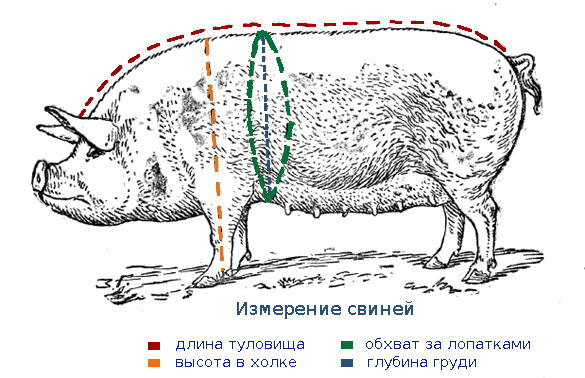

Depending on why you need to find out the weight is chosen and the method of determining it.
How much does the piglet weigh
Large white piglets are rarely born weighing more than 1 kg. The larger the piglet at birth, the more productivity it will show in the future. Babies of the Vietnamese breed are born almost two times less - 500-600 g.
The first month, piglets live on mother's milk, therefore they gain weight very quickly, and a piglet weighing 8-9 kg by the end of 4 weeks is quite normal.
The weight of piglets largely depends on the conditions of detention and, most importantly, a well-designed diet. If the owner approaches the business of growing with knowledge of all the nuances, then the weight of the pig is already by 2 months. averages 25 kg. From that moment on, they begin to feed him intensively, and by 4 months. their weight doubles.
At 6 months (or a little later), when the young animals reach a mass of 90-110 kg, production fattening ends, and they are transferred to the gilts department.
How much a piglet should weigh by months, you can also find out from the table:
| Age in weeks | Age in days | Number of days in the period | Live weight at the end of the period, kg |
| 1 | 1-7 | 7 | 2,6 |
| 2 | 8-14 | 7 | 4,4 |
| 3 | 15-21 | 7 | 6,4 |
| 4 | 22-28 | 7 | 8,9 |
| 5 | 29-35 | 7 | 11,6 |
| 6 | 36-42 | 7 | 14,5 |
| 7 | 43-49 | 7 | 17,51 |
| 8 | 50-56 | 7 | 21,01 |
| 9 | 57-63 | 7 | 24,93 |
| 10 | 64-70 | 7 | 29,06 |
| 11 | 71-77 | 7 | 33,54 |
| 12 | 78-84 | 7 | 38,4 |
| 13 | 85-91 | 7 | 43,4 |
| 14 | 92-98 | 7 | 48,6 |
| 15 | 99-105 | 7 | 53,9 |
| 16 | 106-112 | 7 | 59,4 |
| 17 | 113-119 | 7 | 65 |
Finding out live weight in a quick and easy way is not such an idle question. This indicator can indicate the correctness or inadequacy of the diet used for fattening. In addition, when the animal is handed over for slaughter, the owner will have at least an approximate idea of the expected profit and will be able to control the situation.
Author's rating The author of the article is Ivanov Semyon Sergeevich Farmer with 23 years of experience. Agronomist by education. A villager for reasons of principle. Articles 271 written
Breeding pigs at home can be quite profitable, but in order to track productivity and a number of other tasks, you need to know the exact weight of the animal. At the same time, not every farm has scales of the required configuration. In this case, a very useful skill for the breeder will be the ability to know the weight of the pig without weights. This can be done in several ways, each of which requires detailed consideration.
Pig weight measurement
Growth rate for a piglet
What growth should a newborn or one month old piglet have and how much does a piglet weigh in different periods? The piglet's weight is measured in the first days of its life. It is easier to weigh the piglet. A detailed video will tell the beginner how to distract the animal while the assistant calmly takes measurements from the pig.
The yield of one-month-old piglets (dairy boar) differs from the mass of three-month-old pigs. From the fourth month, the little pig goes to a special diet. The general table is calculated by age, therefore separate schemes are set up for young animals.
The average weight (the general table for ages is not suitable) of piglets depends on the diet and the breed chosen. Monthly pigs weigh up to 10 kg. At 3 months, the weight of the boar is up to 25 kg. At 6 months of age, the pig weighs up to 80 kg.
Why do you need to know the weight of a pig?
Only a few are able to determine the weight of a pig without weights, even among experienced farmers. Meanwhile, such a skill provides a breeder with a number of advantages and helps to increase the efficiency of growing livestock.
The exact weight of a piglet, when determined periodically, allows you to calculate the rate of weight gain in an animal. As a result, knowing the average values for a particular breed, it is possible to judge the effectiveness of the diet used to feed young animals, and adjust it if the results are unsatisfactory.In this case, the menu is supplemented with various vitamins and more nutritious food.
Attention! Identification of a steady decline in the weight of a piglet may be the main sign of a developing disease, which will help to organize timely treatment measures in the future.
The weight of an adult pig will allow you to accurately calculate the daily feed rate for the animal and the composition of the diet. This will allow the breeder to:
- more rational use of available feed stocks;
- increase weight gain in an animal;
- prevent obesity;
- improve the taste of meat before slaughter.
But it is worth noting that the measurement methods indicated below give only approximate values for the mass of the pig, assuming a certain error. Therefore, in the case of selling pork after cutting, it is recommended to weigh all meat products on a conventional electronic scale.
Methods for determining weight without scales
There are several different ways to determine the weight of a pig without using a scale. The most used among them are three:
- According to the measurement table.
- With the help of the coefficient of condition.
- By age.
According to the measurement table
The method for measuring piglet body weight, which uses a pig weight table, is one of the simplest, but at the same time the most accurate. The error of this method of calculating weight ranges from 4-10%.
To implement the calculations, it is initially necessary to carry out 2 measurements of the animal's body:
- Pig chest girth. The easiest way to carry out this procedure is with a measuring tape. It is wrapped vertically around the chest and back of the animal, so that one side of the tape touches the back edge of the shoulder blades.
- Pig body length. After the end of the previous measurements, the tape is stretched along the back of the animal, while its beginning is applied to the base of the pig's head, and the measurement is carried out in the area of the base of the tail.
When measuring, to obtain the most accurate values, it is extremely important to consider the following points:
- the pig must stand during the measurements;
- the animal's head should be slightly raised up;
- measurements are taken 3 hours before the piglet eats.
To comply with the first two points, the animal must be interested in something. Most often, a small container with food is used for this, which is brought to the pig's nose at the desired height. While the pig sniffs the treat and stands motionless, the performer quickly takes the necessary measurements.
The data obtained during the measurement is substituted into the corresponding column and row in the table (it is presented below). After that, they find the point of their intersection, it will indicate the weight of the individual, the measurements of which were carried out.
Pig Weight Measurement Chart
For example, if the body length of an adult pig is 1.26 m with a chest girth of 1.24 m, then the weight of such an animal is approximately 161 kg.
Using the Body Condition Ratio
The second method is used when there is no access to the table. It presupposes more complex calculations based on the same measurements of the animal and a certain value of the coefficient of fatness of the animal.
The indicated coefficients have clear meanings, they are quite easy to remember:
- for animals with insufficient fatness, the coefficient is 162;
- for the deduction of the body weight of pigs with an average degree of nutrition, this figure is 156;
- when determining the weight of animals with pronounced signs of obesity, the value 142 is used.
The desired indicator is selected by assessing the pigs by eye. Accordingly, for the right choice in such a matter, a certain skill is required.
Further calculations are carried out according to the following plan:
- The size of the girth of the thoracic region of the pig is multiplied by the length of its body from the back of the head to the base of the tail.
- The resulting value is divided by the coefficient selected after evaluating the constitution of the animal.
The number obtained as a result of such calculations, just and assumes the body weight of the pig.
For example, the body length of a piglet is 58 cm. His chest girth is 72 cm. The constitution is assessed as medium well-fed. In this case, the calculations will be as follows:
(58x72): 161 = 25.9
Accordingly, the weight of the young is 25.9 kg. Comparing this value with the table, we see that the corresponding line contains the number 25. Taking into account the existing error, we can conclude that the method is effective.
By age
Some breeders determine the weight of an animal based on its age. Undoubtedly, this parameter affects the weight of the animal. But with this approach, the error is significantly higher, so it is possible to determine only the average weight of the pig without specific values. This may be due to the difference in weight between animals of different breeds. In addition, the diet and housing conditions that apply on the farm also play an important role in gaining weight.
Fattened pigs
There are a lot of tables for determining pigs by age on the Internet. Moreover, in addition to the general ones, you can also find more specialized assemblies of values on the network, focused on a specific breed line of pigs and conditions of detention.
It is extremely useful for a breeder to know the approximate weight of a pig. This value allows you to timely adjust the animal's diet in order to increase productivity, to prevent the development of various diseases in time, to clearly determine the daily feeding rate of the animal. But to determine this value at home, it is not necessary to purchase expensive electronic scales. It is enough to carefully familiarize yourself with the above methods for determining the body weight of pets.
Description and dimensions of the wild boar
The wild boar belongs to the order of cloven-hoofed animals and forms a separate genus in the family. It is also often called a boar. This animal is the direct ancestor of the current domestic pig. As for the appearance, it is quite easy to distinguish it from the modern domestic boar.
The wild boar has denser physique and longer legs. The head shape of a wild boar is elongated. The ears on the head are long and erect. Males differ from females in more developed upper and lower canines. The body of the wild boar is covered with coarse long hair. There is a mane on the head and back. In winter, the fur becomes denser and thinns in summer. Hairline colors can be gray, dark or brown.
As for the size of the boar, it can vary depending on the habitat of the animal. The farther north a wild boar lives, the larger it will be. The smallest individuals can be found in southeast Asia and southern India. The mass of such wild boars reaches only 45 kg. But in the Carpathians, wild boars can weigh about 200 kg. The largest individuals live in the regions of the Urals on the territory of Russia. Their mass reaches as much as 300 kg. The maximum weight recorded was 320 kg. Large wild boars weighing 150 kg can also be found in Italy. In France, the mass of wild boars can reach 230 kg.
Average weight of wild boars is 100 kg. The body length of the animal reaches 2 m, and the height at the withers is 110 cm. The length of a boar's tail does not exceed 40 cm. And the length of the canines can range from 6 to 12 cm.

